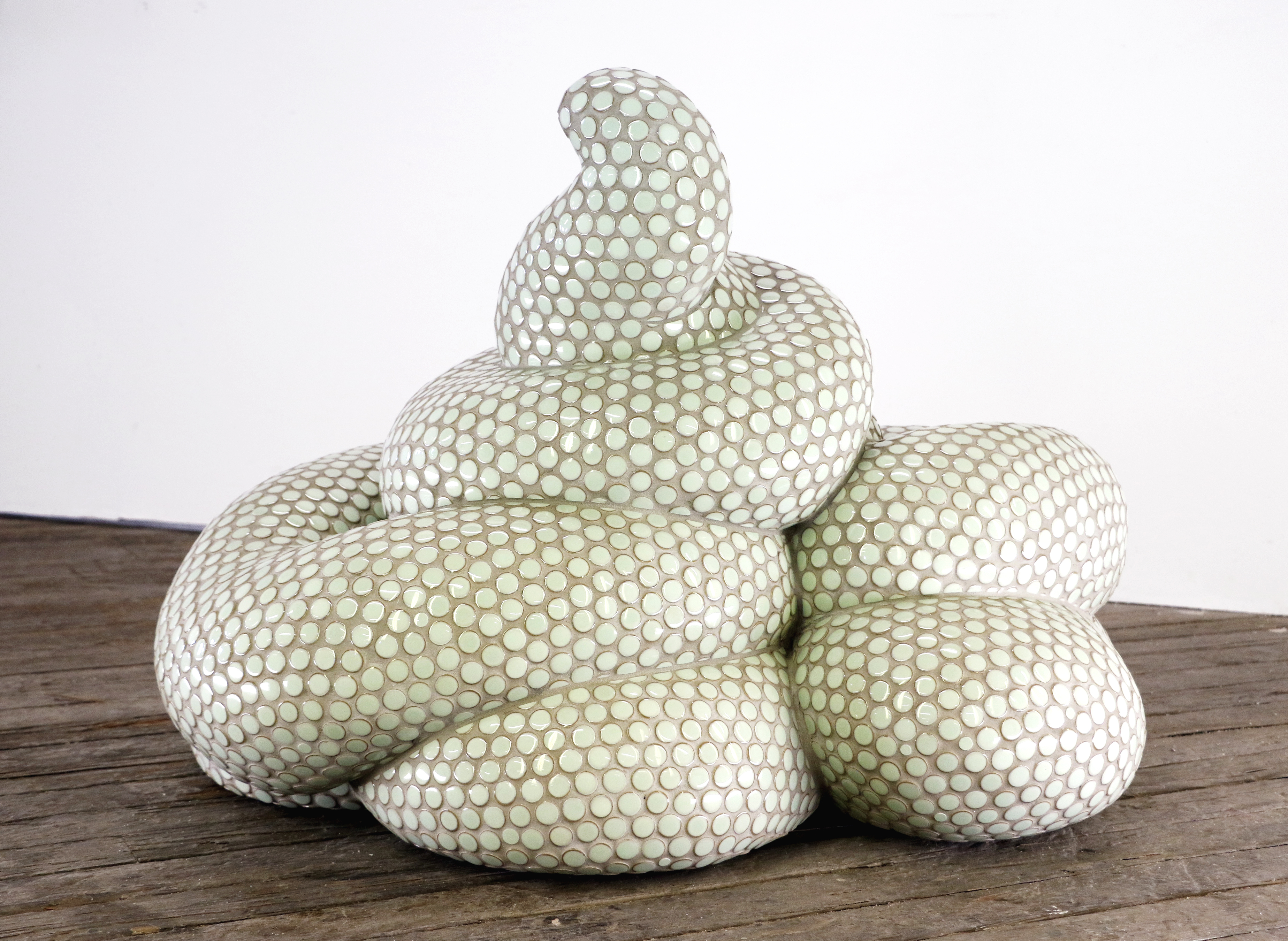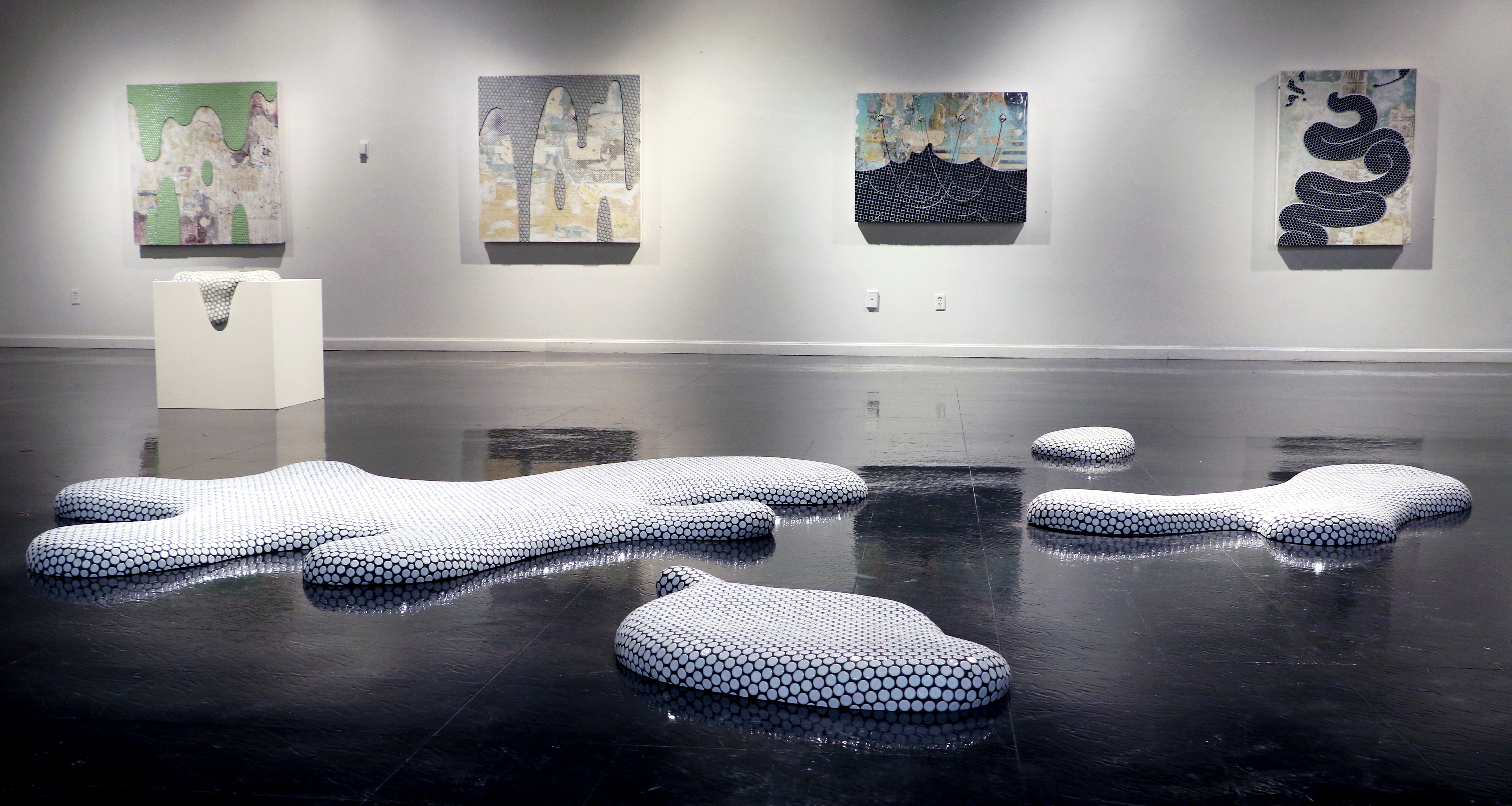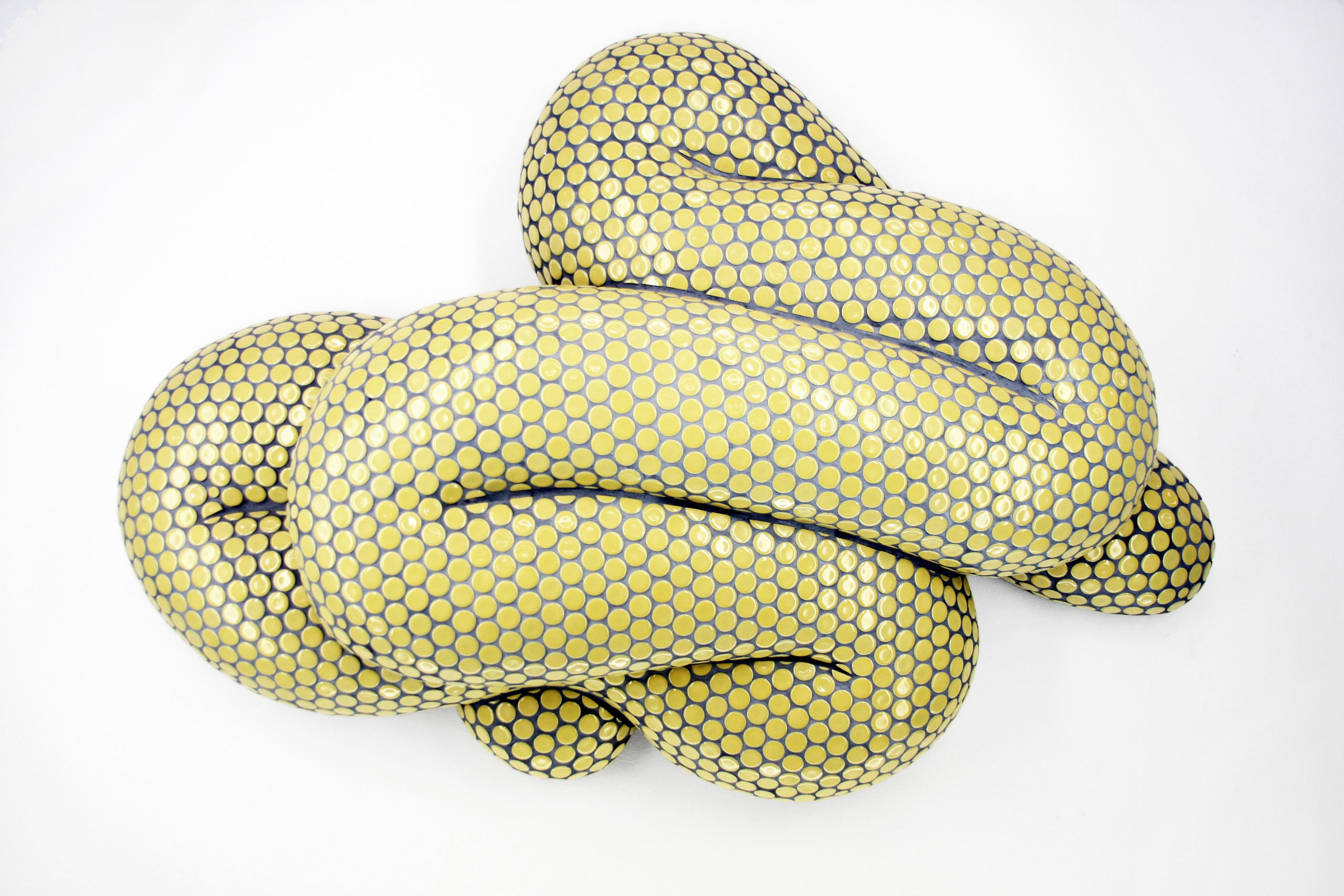Pictured: Mustard Kink // Brett Reif, 2016
Let me say this: Brett Reif is not just a Kansas City-based artist specializing in non-traditional wall work, sculpture and installation, as one might discern from a quick perusal of his biography. He’s a veritable modern-day artistic philosopher, wielding wisdom as he welds and shapes his characteristically evocative work.
Or perhaps his work shapes him. It’s hard to know, like an avante-garde chicken-or-egg scenario, whether the art has made Brett the sagacious sculptor he is today or vice versa. But why don’t you decide for yourself …
MELISSA KANDEL: Your work is highly influenced by the Arte Povera movement of 1960s Italy, an avant-garde form of expression most significantly noted for its artists’ use of “poor,” commonplace materials (earth, rocks, clothing, paper) that was as much a critique on consumerist culture as it was a statement about the complex relationship between the past and present; Arte Povera creations (often sculptures) showed how the old and new when presented together could create powerful distortions about one’s sense of time. So tell me: What about the Arte Povera movement specifically spoke to you as an artist and why do you draw so much inspiration from its central ideas?
BRETT REIF: I think in materials, textures and surfaces that’s where art begins for me. Arte Povera inspired me when I first encountered it in Paris at the Centre Pompidou for a post-minimalist show back in the early 90s. I saw Jannis Kounellis, Michelangelo Pistoletto, Mario Merz and many others for the first time and felt a kinship and a creative opportunity. I previously thought art had to be imagistic or conceptual, based on idea or subject matter as the catalyst. I found in Arte Povera that the materials, the raw stuff, could be in the starring role. Ever since, I have felt empowered to start with a material/process then design, feel and express from there. I also relate intuitively with the central themes of Arte Povera: poetry through work, beauty in the common and poetry of the ordinary.

Run Off Installation // Brett Reif, 2016
You once described your use of “poor” materials—wallpaper, phone book material, bathroom tile—to be much like a poet who composes verse with words. How do the Arte Povera-inspired elements you employ build the story of your art?
A poet uses language by wrestling with words to highlight purpose or intent. When a poet uses a simile or metaphor to compare two unlike things or ideas, he or she means to tap into a general meaning to elucidate an abstract notion; for example, “time is a river,” is a metaphor that relates something that can be seen—a river—to something that cannot be seen. One can drag one’s hand through a river and feel water; one cannot touch time nor feel it. Yet both time and the river move constantly on; therefore, one perceives the nature of abstract time better by comparative analogy with a concrete river.
In the same way, I rescue materials from their mundane functions and build emotion, symbolism or contradiction into their surfaces, textures and shapes, making an artistic metaphor. In this way mere wallpaper becomes desolate or distressed and tile becomes nature or body. The meaning of both materials is transformed through artistic perception.
The shapes of the works along with the materials often ironically relate and contrast each other, leading the viewer to reconcile contradictions and participate in the creation of each piece. “Big Spill,” for example, is a large sculpted puddle inspired by a milk spill on a kitchen floor, but the tile is not in fact the floor but the spill. That simple juxtaposition along with the unexpected scale evokes a playful contradiction. This is a powerful place from which an artist can create.
It forces the viewer to leave the known and attempt to form meaning from the unknown.

“Plop, green toxic” // Brett Reif, 2016
Let’s talk about some of the recent work included in your “Run Off” show at Studios Inc. in Kansas City, like “The Big Spill no use crying” and “Plop, green toxic.” These pieces, made in part from recycled foam, are a curious juxtaposition of comedy and something much more foreboding. Obviously toxic waste is a huge problem today and I think it’s telling of you to use materials that are themselves contributing to the issue, repurposed as jarring yet humorous artistic commentary. What’s the message you’re trying to convey with the seriously funny nature of these pieces?
The “Big Spill” and the Plop Series harness a theme of environmental accident. They also describe domestic disaster. My intent is to suggest, so that the viewer’s imagination can take the work in the direction of their imagination. While the plops are funny in that they can be perceived as piles of shit, they are purposefully playful, not specifically illustrative of poop. The original form reference was toothpaste. That said, the Styrofoam material I sculpt with has environmental concerns as it is not biodegradable. Using foam may not be environmentally wise though classically sculpted; however, foam is a significant and common architectural building material. Most of Las Vegas is made of foam! Contemporary houses and buildings also use foam as a common surface and infrastructure medium. I use the same technology to sculpt, and I consider the appropriation of popular building materials important to the meaning of the works: Cities built of foam do not bode well for the future. My art reflects how our world is made, yet I try to be as environmentally sensitive as I can. I use scraps, and cutoffs from local foam manufacturers and recycle clean foam back to those companies. I stopped using hot-wire cutters, since burning foam is toxic for people as well as the planet.

The Big Spill // Brett Reif, 2016
In your Plops and Spills Series, there’s another disruption happening, and that’s the conscious questioning of the traditional exhibition experience. “The Big Spill no use crying,” for instance, is comprised of four components quite literally spilling across the floor; the piece is not hanging on a gallery wall or inside a glass case but lives right there on the ground for the viewer to engage with and enjoy. Is this rejection of exhibition norms a function of the work you create or part of a larger message about society’s perhaps too-narrow definition of art?
The installation of the “Big Spill” and scale and placement of the Plop Series embraces the natural world rather than opposing “exhibition norms.” While it’s true that insulated, framed, delineated art experiences at museums are the norm, “Big Spill” activates space unlike traditional sculpture. Much of contemporary art also acts outside of tradition. I’m certainly not being innovative. I am embracing the nontraditional. Artists create in a way that allows the viewer to be reminded of nature and the world; this can be achieved inside of exhibition spaces.
Rather than putting art in the museum, I imagine putting art on the museum, running it down the walls and floors in a way that makes the viewer notice.
This strategy also activates the exhibition space by turning it into a stage. With the Plop Series, I imagine a viewer seeing piles of tile and wondering what tile monster dumped them here. The museum and gallery exhibition space provides a fantastic, imaginative alternate universe. I treat these spaces like a stage with sculpture actors, not a pedestal with objects displayed.

Tidings Revolution // Brett Reif, 2016
Your newest creations—like Tidings, Revolution and Tidings, Bliss—use oyster shells, an homage to your childhood growing up in New Orleans, positioned across mixed media pillows. My initial reaction was how mismatched the shells looked with the very industrial-like, pattern of the bathroom tiles and foam surrounding them but once my eyes adjusted, it all seemed to fit. Is this series meant to emphasize the complex relationship between manufactured, everyday commodities and organic elements of nature?
Yes! My new series is meant to emphasize relationships between manmade and natural. For the Tidings Series, I used oyster shells because they trigger a memory of New Orleans, my hometown; they remind me of the shell roads of my childhood. The tile ‘pillows’ fuse domestic objects in juxtaposition with domestic surfaces. Pillows, curtains and scrolls influence the form of the ‘pillows’ but it isn’t clear to me as the maker what the form is! As form poetry, I’m distorting, and there is no word for what these shapes actually are.
How exciting art can be, to invent things that never existed!
The shells are a surprisingly excellent companion for the white tile. Like a comedic part, an Abbot and Costello, a Penn and Teller, the shells and tile are so different, yet so complimentary. The oyster is raw nature, while the tile is so clean and manufactured—they represent two different symbolic and associative worlds. Yet both are water shields, hardened forms designed to protect in a wet world—so they are also very similar. The arrangement of the shells in the series suggest cycles, planetary movement or primitive beauty. The two materials along with the domestic pillow coalesce into something more than the sum of its parts. One of the highlights of being an artist is being able to create something unique from pre-existing, seemingly ordinary stuff. The lesson is: There is no such thing as ordinary.

Billow // Brett Reif, 2016
When commenting about a recent showing you held at Weinberger Fine Art—“In Beauty there is Guilt”—a writer from the KC Metropolis said, “It is a show for those who want to be awakened.” How do you want viewers to be awakened by your art?
To segue from my last answer, there is no such thing as ordinary. If I take materials, surfaces and objects that are familiar and make them new, exciting, poetic and expressive—that is my artistic achievement. We live in very busy, chaotic worlds; as adults we have to filter and focus to get through our days. It’s a modern survival mechanism to tune out chaos perhaps but that survival comes at a cost to our creative, imaginative lives. In daily life, most adults suppress the playful and creative. When I taught elementary school, I would draw a round shape on the chalk board and ask the children, “What is it?” They would respond, it’s a pizza, it’s a sun, it’s a wheel and so on. In college I would do the same, draw a round shape and ask the college kids, “What is it?” The answer was always the same. It’s a circle. No creativity, no mystery, no play. As an artist I have an opportunity to address that insulated rational-bound protective coating that we put on ourselves as part of “growing up.” I can make art with materials and surfaces that people know but give it to them in a way that seems totally different. It is pleasurable to see something fresh. And if the viewers’ imagination is really stoked, then they leave the gallery or museum wondering, what could that pile of sticks be, what about those rocks, or this pile of socks, perhaps the viewer stops seeing things for what they mean and sees things for what they can become.

Concertina Movements // Brett Reif, 2016
This might sound cliché but the work you do really transforms the ordinary—like bathroom tiles or drains or foam—into something quite extraordinary. What in your artistic reservoir allows you to take the mundane and turn it into something wholly original and fresh? Have you always been able to look at something people might pass by every day without a second glance and find the art within?
Yes and no. I am wired with a heightened emotional sensitivity and perceptual ability as my friends and family will humorously attest. As a kid I came pre-packaged with mystery and extraordinary built in. We play by turning sticks into a fort or blocks into buildings. Like most children, I had a highly active imagination. This imagination was schooled out of me. I was a disaffected high schooler navigating my parents tumultuous divorce and 18 years of Christian and Catholic school. I relied on my imagination as a way of coping and processing my world. It wasn’t until college with some great teachers that I recognized how powerful imagination is. Anything can be anything is a pretty awesome concept. I was able to embrace it. That trait of using common and ordinary or found stuff has been in my art from the beginning. I also really enjoy letting myself be a kid and imagine and play. The difference in my work now from earlier in my career is that the sculptural form is contrasting my materials. The outcomes become irreverent, funny and mysterious. I don’t feel that I am making art in a manner or style of anyone else. I see my work as original.

Downpoor // Brett Reif, 2016
You have a distinct point of view and style that is boldly reflected in your art. I know you work with many students and interns, so what did you tell these young artists struggling to find their own aesthetic voice and expression? How do you inspire others who are inspired by you?
I tell students and interns the truth. Art is hard. It is a passion and a calling that often is under recognized and under appreciated by society at large. When you make the choice to make art, and make your life around making and expressing, you are choosing a mysterious, long and often lonely journey. Students underestimate the duration of the career. It takes a decade or more of intense focus before you can really manifest personal greatness. I always stress how long this process takes.
Be prepared for a long, long journey. Be patient. Keep at it. Be persistent. And if necessary, be hard-headed.
That is one challenge. The other major obstacle is how insecure art is. To invent something new, you never know what is right. There is no book to consult. No advisor really knows. You are alone with your art. It can be a scary and intimidating place. Add deep emotion and expression and artists often are confronting issues and ideas that can be frightful. I liken the artist to elite world adventurers. Emotional spelunkers who delve into the depths of humanity, face their fears, know themselves and come back with knowledge and stories for the viewer. The journey changes the artist, the artist shares the change and the art can change the world.



I love Brett Reif’s work and find it compelling in a way few other works of art are. The combination of organic shells with cold hard tiles over foam is masterful, a lesson in the composition of our world. These juxtapositions seem casual as with The Big Spill, which is my favorite piece; however, there is nothing casual about this piece which forces onlookers to walk around it, encountering it dead on not safely on a wall, not something to contemplate as outside of a picture window. If the toxic spill is out there somewhere in the wild ocean, it must be confronted directly as one must confront this piece. It is not in your face art. It comes zooming out of the nowhere of perspective used in a totally new way. Congratulations to this wonderful artist and sculptor.